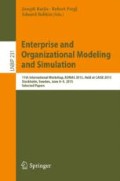Abstract
Two different types of processes can be distinguished: well-structured routine processes and agile processes where the control-flow cannot be predefined a priori. In a similar way, two modeling paradigms exist whereby procedural models are more adequate for routine processes and declarative models are more suitable for agile processes. Often business analysts are not confident in understanding process models; this holds even more for declarative process models. Natural language support for this kind of processes in order to improve their readability is desirable. In the work at hand we define a technique that transforms declarative models to intuitive natural language texts. Hereof, the approach focuses on content determination and structuring the output texts.
Access this chapter
Tax calculation will be finalised at checkout
Purchases are for personal use only
Notes
- 1.
Our binary trees are object trees without optional associations. Hence, the meta model prevents information loss during serialization.
- 2.
Notations vary; we have chosen the notation used in [20].
- 3.
http://www.cogentex.com/technology/realpro/index.shtml, l.a.: March 13th, 2015.
References
Dumas, M., Rosa, M.L., Mendling, J., Reijers, H.A.: Fundamentals of Business Process Management. Springer, Heidelberg (2013)
Jablonski, S.: MOBILE: A modular workflow model and architecture. In: Working Conference on Dynamic Modelling and Information Systems (1994)
van der Aalst, W., Pesic, M., Schonenberg, H.: Declarative workflows: balancing between flexibility and support. Comput. Sci. Res. Dev. 23(2), 99–113 (2009)
Pichler, P., Weber, B., Zugal, S., Pinggera, J., Mendling, J., Reijers, H.: Imperative versus declarative process modeling languages: an empirical investigation. In: Daniel, F., Barkaoui, K., Dustdar, S. (eds.) Business Process Management Workshops. LNBIP, vol. 99, pp. 383–394. Springer, Heidelberg (2012)
Leopold, H., Mendling, J., Polyvyanyy, A.: Supporting process model validation through natural language generation. IEEE TSE 40(8), 818–840 (2014)
Reiter, E., Dale, R.: Building Natural Language Generation Systems. Cambridge University Press, New York (2000)
Dalianis, H.: A method for validating a conceptual model by natural language discourse generation. In: Loucopoulos, P. (ed.) Advanced Information Systems Engineering. LNCS, vol. 593, pp. 425–444. Springer, Heidelberg (1992)
Meziane, F., Athanasakis, N., Ananiadou, S.: Generating natural language specifications from uml class diagrams. Req. Eng. 13(1), 1–18 (2008)
Malik, S., Bajwa, I.S.: Back to origin: transformation of business process models to business rules. In: La Rosa, M., Soffer, P. (eds.) Business Process Management Workshops. LNBIP, vol. 132, pp. 611–622. Springer, Heidelberg (2013)
Zeising, M., Schönig, S., Jablonski, S.: Towards a common platform for the support of routine and agile business processes. In: Collaborative Computing: Networking, Applications and Worksharing (2014)
Schönig, S., Cabanillas, C., Jablonski, S., Mendling, J.: Mining the organisational perspective in agile business processes. In: Gaaloul, K., Schmidt, R., Nurcan, S., Guerreiro, S., Ma, Q. (eds.) Enterprise, Business-Process and Information Systems Modeling. LNBIP, vol. 214, pp. 37–52. Springer, Heidelberg (2015)
Reiter, E.: Has a consensus nl generation architecture appeared, and is it psycholinguistically plausible?. In: Proceedings of the 7th INLG, pp. 163–170 (1994)
Lavoie, B., Rambow, O.: A fast and portable realizer for text generation systems. In: 5th ANLP Conference, ANLC 1997, pp. 265–268. ACL (1997)
Coşkunçay, A.: An Approach for Generating Natural Language Specifications by Utilizing Business Process Models, Master’s thesis, Middle East TU (2010)
Burden, H., Heldal, R.: Natural language generation from class diagrams. In: Proceedings of the 8th International Workshop on MoDeVVa. ACM (2011)
Lavoie, B., Rambow, O., Reiter, E.: Customizable descriptions of object-oriented models. In: Proceedings of the 5th Conference on ANLP, pp. 253–256 (1997)
Fellbaum, C.: WordNet: An Electronic Lexical Database. Bradford Books, Cambridge (1998)
Leopold, H., Smirnov, S., Mendling, J.: Refactoring of process model activity labels. In: Hopfe, C.J., Rezgui, Y., Mètais, E., Preece, A., Li, H. (eds.) Natural Language Processing and Information Systems. LNCS, vol. 6177, pp. 268–276. Springer, Heidelberg (2010)
Russell, N., van der Aalst, W.M., Ter Hofstede, A.H., Edmond, D.: Workflow resource patterns: identification, representation and tool support. In: Pastor, O., e Cunha, J.F. (eds.) Advanced Information Systems Engineering. LNCS, vol. 3520, pp. 216–232. Springer, Heidelberg (2005)
Uszkoreit, H.: Categorial Unification Grammars. In: Proceedings of COLING (1986)
Bar-Hillel, Y.: A quasi-arithmetical notation for syntactic description. Language 29, 47–58 (1953)
Shieber, S.M.: An Introduction to Unification-Based Approaches to Grammar. CSLI Lecture Notes Series, vol. 4. Center for SLI, Stanford (1986)
McKeown, K.R.: Text Generation: Using Discourse Strategies and Focus Constraints to Generate Natural Language Text. Cambridge University Press, New York (1985)
Mann, W.C., Thompson, S.A.: Rhetorical structure theory: toward a functional theory of text organization. Text 8(3), 243–281 (1988)
Melčuk, I.A.: Dependency Syntax: Theory and Practice. Daw Book Collectors, State University Press of New York, New York (1988)
Author information
Authors and Affiliations
Corresponding author
Editor information
Editors and Affiliations
Rights and permissions
Copyright information
© 2015 Springer International Publishing Switzerland
About this paper
Cite this paper
Ackermann, L., Schönig, S., Zeising, M., Jablonski, S. (2015). Natural Language Generation for Declarative Process Models. In: Barjis, J., Pergl, R., Babkin, E. (eds) Enterprise and Organizational Modeling and Simulation. EOMAS 2015. Lecture Notes in Business Information Processing, vol 231. Springer, Cham. https://doi.org/10.1007/978-3-319-24626-0_1
Download citation
DOI: https://doi.org/10.1007/978-3-319-24626-0_1
Published:
Publisher Name: Springer, Cham
Print ISBN: 978-3-319-24625-3
Online ISBN: 978-3-319-24626-0
eBook Packages: Computer ScienceComputer Science (R0)

